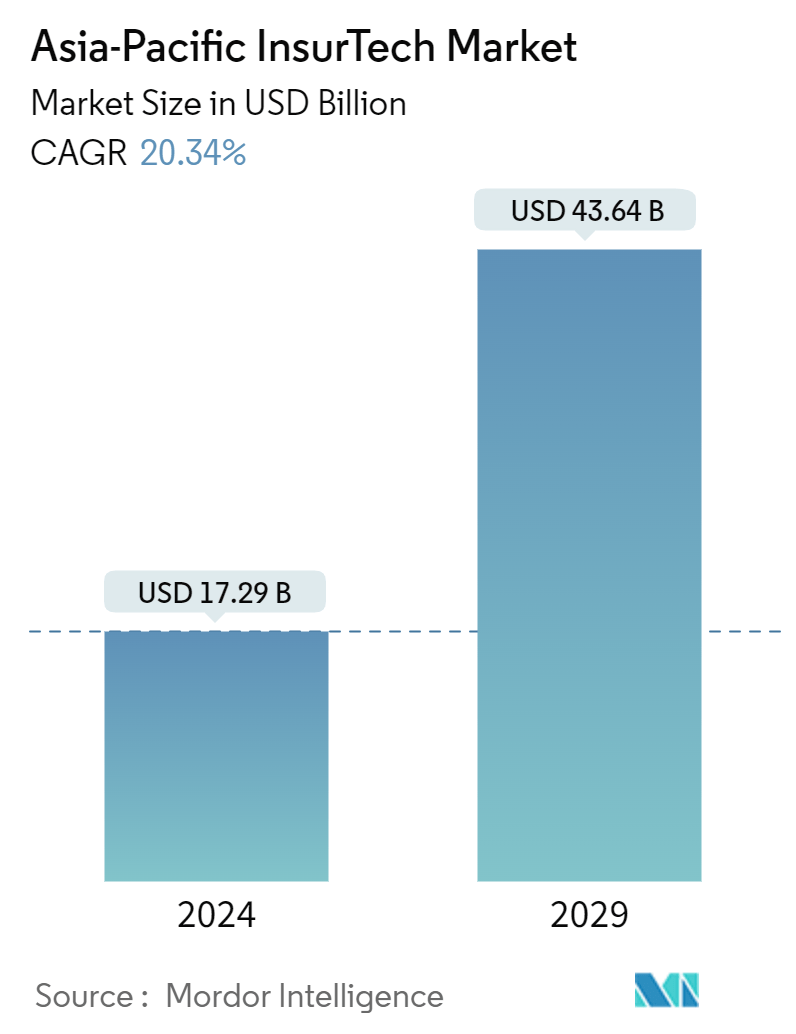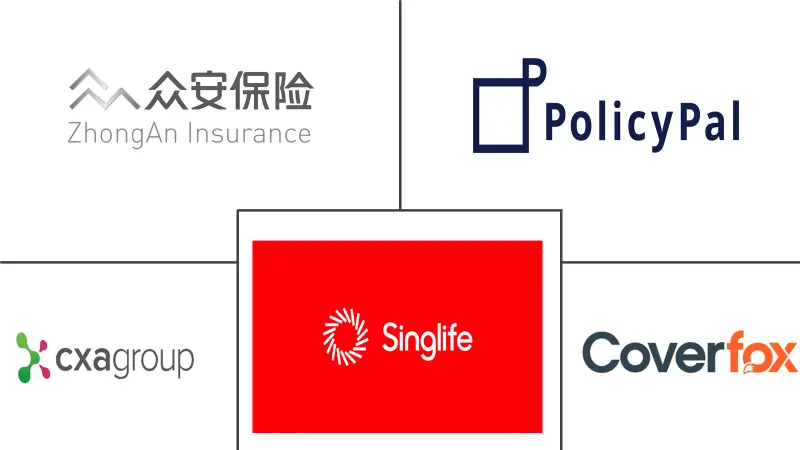Market Size of Asia-Pacific InsurTech Industry

| Study Period | 2020 - 2029 |
| Base Year For Estimation | 2023 |
| Market Size (2024) | USD 17.29 Billion |
| Market Size (2029) | USD 43.64 Billion |
| CAGR (2024 - 2029) | 20.34 % |
| Market Concentration | Low |
Major Players
*Disclaimer: Major Players sorted in no particular order |
Asia-Pacific InsurTech Market Analysis
The Asia-Pacific InsurTech Market size is estimated at USD 17.29 billion in 2024, and is expected to reach USD 43.64 billion by 2029, growing at a CAGR of 20.34% during the forecast period (2024-2029).
The insurance industry across Asia-Pacific countries is rapidly embracing technology. Companies are adopting artificial intelligence, big data analytics, and blockchain to streamline processes, elevate customer experiences, and tailor coverage. This tech drive is fueled by the region's tech-savvy consumers, who demand seamless digital interactions. Consequently, the regional market is witnessing the emergence of novel business models such as peer-to-peer insurance and on-demand coverage. Beyond tech adoption, businesses are also innovating in terms of product offerings and distribution channels, yielding impressive results. Leading players are not only setting the stage for long-term success but also capitalizing on immediate opportunities. With its vast population and surging internet penetration, the regional market is a hotbed for insurtech growth.
The insurance market’s transformation is further supported by regulatory frameworks that encourage innovation and competition. Additionally, partnerships between traditional insurers and tech startups are becoming increasingly common, fostering a collaborative environment that drives industry-wide advancements.
Asia-Pacific InsurTech Industry Segmentation
Insurtech is using new technology to improve the efficiency of how insurance is sold right now. This report offers a comprehensive analysis of the Asia-Pacific insurtech market. It delves into market dynamics, highlights emerging trends across segments and regional markets, and provides insights into diverse product and application types. Additionally, the report scrutinizes key players and the competitive landscape.
The Asia-Pacific insurtech market is segmented by insurance lines, which include health, life, and non-life. By country, the market is segmented into China, India, Japan, Hong Kong, Singapore, Indonesia, and the Rest of Asia-Pacific. The report offers market sizes and forecasts in terms of value (USD) for all the above segments.
| By Insurance Line | |
| Health | |
| Life | |
| Non-life |
| By Country | |
| China | |
| India | |
| Singapore | |
| Hong Kong | |
| Japan | |
| Indonesia | |
| Rest of Asia-Pacific |
Asia-Pacific InsurTech Market Size Summary
The Asia-Pacific InsurTech market is experiencing significant growth, driven by factors such as a younger demographic, low insurance penetration, and the rapid adoption of technologies like mobility and 5G. The region has seen a surge in InsurTech activities, particularly post-pandemic, with China and India leading the charge by hosting a substantial portion of private InsurTech companies and attracting a majority of the region's investment. The market is characterized by the rapid digitalization and adoption of innovative business models, spurred by increased smartphone and internet penetration and evolving customer preferences. Despite challenges such as regulatory variations and privacy concerns, the market continues to expand, with emerging economies offering substantial growth opportunities.
The non-life insurance sector, encompassing motor, property, and liability insurance, is witnessing robust premium growth, particularly in China and South Korea. However, mature markets like Japan face challenges due to demographic shifts and changing consumer expectations. India stands out as a key player in the InsurTech landscape, with numerous technology startups fostering partnerships and collaborations that enhance business processes through advanced analytics. The region is home to over 330 InsurTech companies, with major players including ZhongAn Insurance, SingLife, CXA Group, CoverFox Insurance, and PolicyPal. Recent developments, such as Singlife's partnership with Citi and BlackRock, and Policybazaar.com's launch of the PBPartners app, highlight the ongoing innovation and strategic initiatives shaping the market.
Asia-Pacific InsurTech Market Size - Table of Contents
-
1. MARKET INSIGHTS AND DYNAMICS
-
1.1 Market Overview
-
1.1.1 Insights into Macroeconomic Aspects and Demographics of Asia-Pacific
-
1.1.2 A Brief Note on Insurtech Landscape in Asia-Pacific
-
-
1.2 Market Drivers
-
1.2.1 Increasing Adoption of Digital Technologies
-
1.2.2 Rise of Big Data and Advanced Analytics
-
-
1.3 Market Restraints
-
1.3.1 Complex Regulatory Landscape Restraining the Market
-
1.3.2 Data Privacy and Cybersecurity Concerns
-
-
1.4 Market Opportunities
-
1.4.1 Tapping into the Underserved Markets in the Region is Creating Opportunities
-
-
1.5 Industry Attractiveness - Porter's Five Forces Analysis
-
1.5.1 Bargaining Power of Suppliers
-
1.5.2 Bargaining Power of Consumers
-
1.5.3 Threat of New Entrants
-
1.5.4 Threat of Substitutes
-
1.5.5 Intensity of Competitive Rivalry
-
-
1.6 Insights into Various Technologies Being Used by Insurtech Players in the Region
-
1.7 Insights into Insurtech Regulatory Landscape in Asia-Pacific
-
1.8 Insights into Venture Capital Investments in Insurtech in Asia-Pacific
-
1.9 Impact of the COVID-19 Pandemic on the Industry
-
-
2. MARKET SEGMENTATION
-
2.1 By Insurance Line
-
2.1.1 Health
-
2.1.2 Life
-
2.1.3 Non-life
-
-
2.2 By Country
-
2.2.1 China
-
2.2.2 India
-
2.2.3 Singapore
-
2.2.4 Hong Kong
-
2.2.5 Japan
-
2.2.6 Indonesia
-
2.2.7 Rest of Asia-Pacific
-
-
Asia-Pacific InsurTech Market Size FAQs
How big is the Asia-Pacific InsurTech Market?
The Asia-Pacific InsurTech Market size is expected to reach USD 17.29 billion in 2024 and grow at a CAGR of 20.34% to reach USD 43.64 billion by 2029.
What is the current Asia-Pacific InsurTech Market size?
In 2024, the Asia-Pacific InsurTech Market size is expected to reach USD 17.29 billion.

